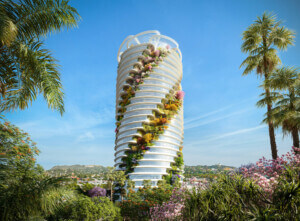The Chicago-based Council on Tall Buildings and Urban Habitat (CTBUH) sought out a deep understanding of sustainability and contextualization in selecting the Best Tall Building of 2011. This year’s worldwide winner, while hardly as tall as last year’s winning Burj Khalifa, went to the KfW Westarkade tower in Frankfurt Germany. The 184-foot-tall tower is projected to use half as much energy as a typical European office building and only a third the energy of a standard U.S. building. The 10th-annual awards ceremony took place November 3 at a distinctly horizontal building in Chicago, Mies van der Rohe’s Crown Hall.
Designed by Sauerbruch Hutton, the KfW Westarkade stood above its contenders by its contextual approach to knitting together Frankfurt’s urban fabric. With a colorful sawtooth glass skin, the tower curves around an irregular site. “Whereas many buildings use color as a way to mask an otherwise unremarkable building, here it contributes an additional rich layer to what is already a remarkable building,” said Peter Murray, one member of the jury. The tower was also awarded the Best Tall Building in Europe.
Frank Gehry’s curvilinear Eight Spruce Street in New York—the tallest residential building in North America—was named the Best Tall Building in the Americas for its iconic undulating skin that offers each unit a bay window overlooking Lower Manhattan. The jury appreciated the building’s unique form as well as the investment it represents in a previously overlooked part of Manhattan.
“As we design for a sustainable future, we desperately need a new definition of beauty that goes beyond skin deep,” said awards chair Rick Cook of Cook+Fox Architects in a statement. “Already being touted as one of the most energy-efficient office buildings in the world, KfW Westarkade stands out as a shining example of a truly environmentally-responsible project. The building has been carefully integrated into its context, forming relationships with its neighboring buildings, streets and parkland, while simultaneously standing out through the playful use of color. Whereas many buildings use color as a way to mask an otherwise unremarkable building, here it contributes an additional rich layer to what is already a remarkable building. Germany already has a strong reputation for achieving natural ventilation in tall office buildings, and Westarkade can now be added most positively to that list.”
The Best Tall Building in Asia & Australia was awarded to the China’s Guangzhou International Finance Center, designed by Wilkinson Eyre Architects. At 1,444 feet tall, the tower is easily the tallest of this year’s winners and incorporates a tapering design and the world’s largest diagrid system to help reduce the bulk of the tower and provide for an aerodynamic form. At night, the diagonal bracing is expressed with lights.
Dubai’s 1,070-foot Index tower by Foster+Partners was named Best Tall Building in the Middle East & Africa. The Index’s use of shaded pools at its base to create micro-climates at the buildings entrances stood out. “The Index presents a new environmental icon for the Middle East, showcasing important passive strategies of orientation, core placement and shading,” said juror Werner Sobek.
In addition to the four top tall buildings, Adrian Smith, principal at Adrian Smith + Gordon Gill Architecture, and Dr. Akira Wada, an expert in seismic design, were both awarded lifetime achievement awards for their contributions to tall architecture.










